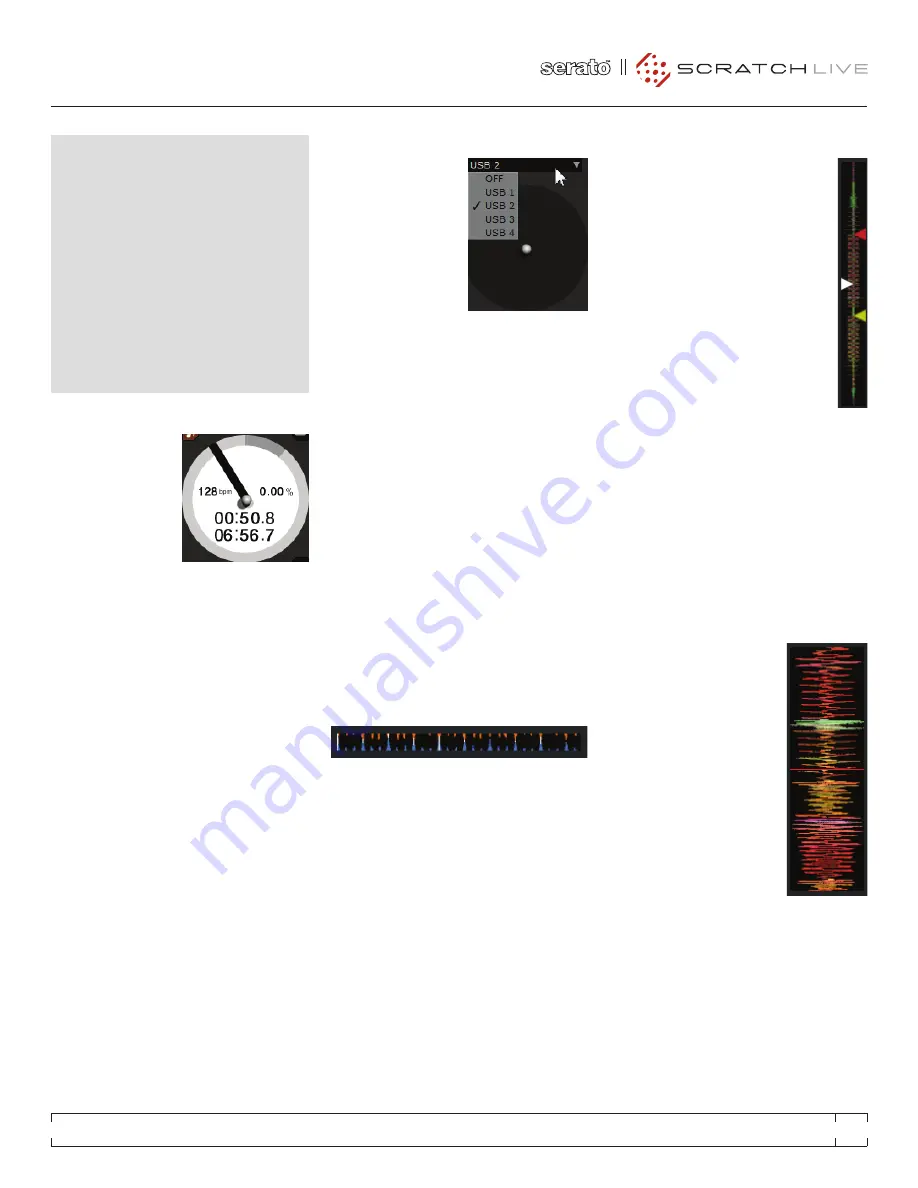
VIRTUAL DECk
The Virtual Deck
shows everything
about the speed
and position of a
track. As the vinyl
rotates, so does the
line on the label.
The circular progress bar around the edge is
a visual representation of the position within
the song, and can be set to flash to warn you
that the track is nearing its end. The time and
remaining time are displayed in minutes and
seconds. The pitched BPM (BPM with pitch
adjustment multiplier added) is shown on the
left of the Virtual Deck, and the turntable speed
as a percentage pitch shift is shown on the right
of the Virtual Deck. If the track has no BPM
information, pitched BPM will not be shown.
If you are playing regular vinyl, notice the
Virtual Deck behaving strangely as Scratch Live
attempts to decode the incoming signal. This
will not cause any problems, but you may find it
distracting. You can unload the currently loaded
track using the Virtual Deck eject button.
TIP: Use the keyboard shortcut shift-alt-
arrow to unload a track from the Virtual Deck.
USB SOURCES & ANALOG INPUTS
Each Virtual Deck in
Scratch Live has a
USB source, which
allows you to select
which Analog input on
the Sixty-Eight is used
to control it. You can
then configure which
Virtual Deck in Scratch
Live plays through which channel on the Sixty-
Eight. To set a USB Source in Scratch Live, click
the USB Source dropdown box above the Virtual
Deck.
Any Virtual Deck with USB Source 1 or 2
selected can output through channels 1 or 2
on the Sixty-Eight, while any Virtual Decks with
USB Source 3 or 4 selected can output through
channels 3 or 4.
Once you have set USB sources for all the
Virtual Decks, use the
PGM Source
knobs on
the Sixty-Eight to select a USB source for that
channel.
VISUAL AIDS
When the track is playing several waveforms are
displayed. Each shows a different aspect of the
track being played.
TEMPO MATCHING DISPLAy
The Tempo Matching display area provides a
helpful tool for beat matching. Scratch Live
detects the beats within the track, and places
a row of orange peaks (for the track on the left
side) above a row of blue peaks (for the track
on the right side) in the Tempo Matching display
area. When the two tracks are matched to the
same tempo, the peaks will line up. The tempo
display is aligned with the beginning of the bar,
so the peaks keep their relative position as the
track plays. This display does not show the
relative timing of the beats, only the tempos of
the tracks. The peaks will still line up when the
tracks are playing at the same tempo, but are
out of sync.
MAIN SCREEN
OVERVIEW
TRACk OVERVIEW DISPLAy
This view provides a complete overview
of the track waveform, and includes
a marker to show the current position
within the track. This view is useful for
finding transitions within the track. The
waveform is colored according to the
sound spectrum – red representing
low frequency bass sounds, green
representing mid frequency sounds and
blue representing high frequency treble
sounds.
You can jump to different positions
within the track by clicking on the Track
Overview display (disabled in ABS
Mode). Grey lines behind the overview show the
length of the track – a thin grey line every minute,
and a thick grey line every 5 minutes. The
overview will be filled when you load the track
onto a Virtual Deck. On slower computers, you
should disable
Autofill overviews
in the Library
tab of the Setup screen.
SEE “PREPARING yOUR
FILES” ON PAGE 17 AND “AUTOFILL OVERVIEWS”
ON PAGE 40.
MAIN WAVEFORM DISPLAy
This view provides a close-up
of the track, including color
coding to show the frequency
of the sound; red representing
low frequency bass, green
representing mid-frequencies
and blue representing high-
frequency treble sounds.
You can also switch to a
three-band spectrum view
by holding the ctrl key and
clicking on the waveform. Click
on the waveform to ‘scrub’ or
make fine adjustments to your
position within the track. This applies to INT
Mode only, and may be useful if you wish to set
cue points in your tracks without your turntables
or CD players connected. The Main Waveform is
zoomed around the current position in the track.
SEE “CUE POINTS” ON PAGE 24 AND “SCRATCH
LIVE MODES” ON PAGE 22.
RANE SIXTY-EIGHT
FOR
SERATO SCRATCH LIVE •
OPERATOR’S MANUAL
2.2
19






























